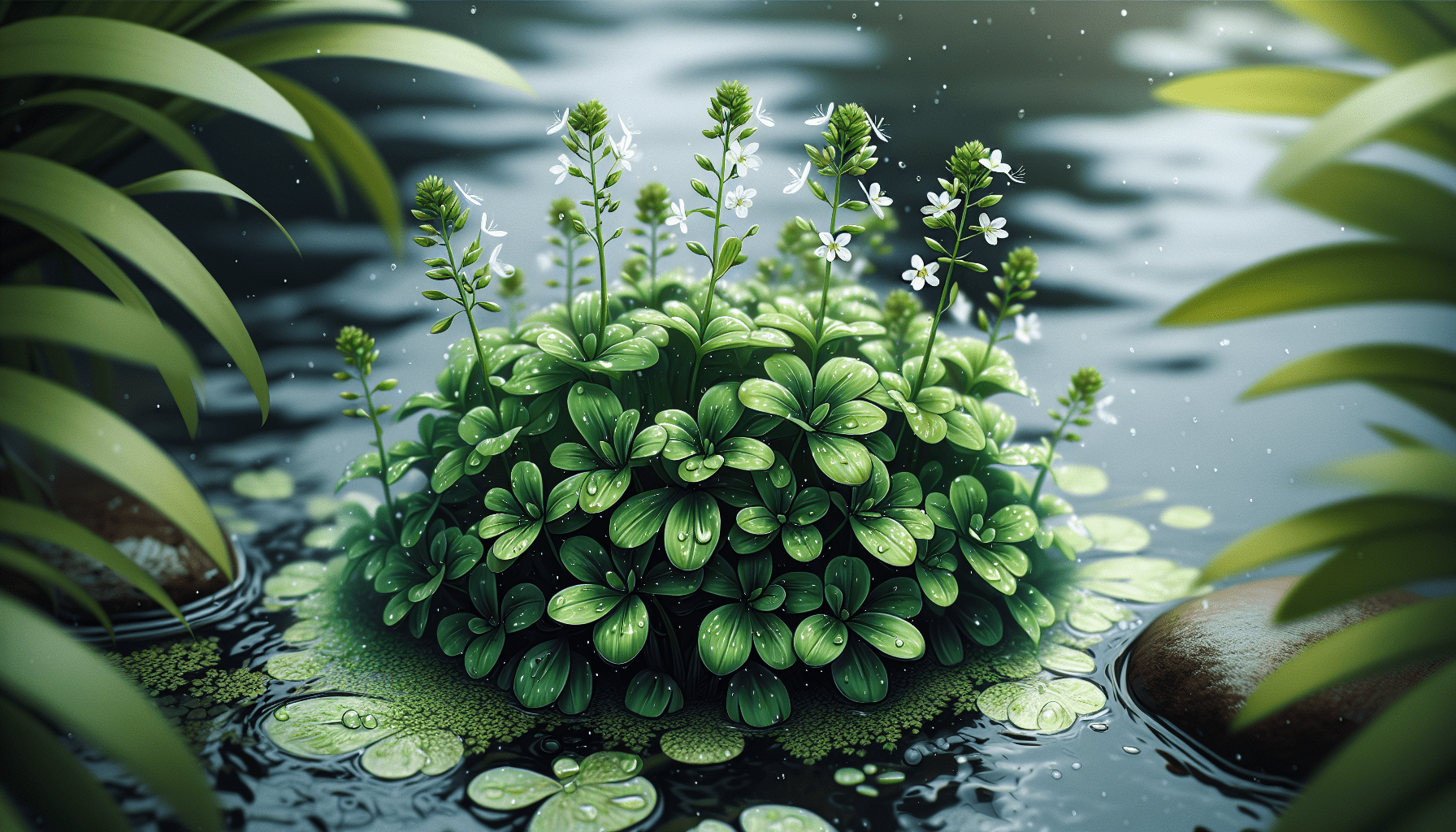With a name synonymous with its region of origin and its aquatic nature, the African Watercress stirs interest in its unique growth patterns and characteristics. This article explores the world of the African Watercress, an aquatic plant that makes its home in the diverse and elaborate ecosystems of the African continents. You will discover its botanical properties, ecological role, and the potential for its cultivation and use in different sectors. This discussion on African Watercress will take you on a journey through its natural history, while offering insight into its significance and peculiarities.
Overview of African Watercress
African Watercress, an aquatic perennial plant, is native to Africa but has now spread across different continents, offering both culinary and medicinal attributes. This comprehensive article will delve into the details of this unique green-leaved plant, providing you with an intimate understanding of its origin, characteristics, uses, cultivation methods, environmental impacts, and contribution to cultural significance. This will enable you to appreciate its unique merits and potential applications in various domains.
Origin and habitat of African Watercress
The origin of African Watercress, as indicated by its name, is traced back to the continent of Africa. The plant thrives in an aquatic environment, predominantly inhabiting freshwater bodies that have a slow movement such as streams, reservoirs, or marshy areas. However, it is capable of adapting to various environments and is thus found in other settings too, owing to its robust nature.
Scientific classification of African Watercress
From a scientific perspective, African Watercress is classified under the Brassicaceae family. More accurately, its taxonomic classification involves the kingdom Plantae, class Magnoliopsida, order Brassicales, and genus Nasturtium. Its scientific name is Nasturtium officinale, which is commonly referred to as Watercress in different parts of the world.
Physical characteristics of the plant
African Watercress is a vigorous, fast-growing plant with hollow, floating stems. Its appearance is marked by shiny green leaves that are pinnate and smooth, typically featuring three to nine leaflets. Each leaflet is ovate and serrated at the edges. The plant’s small white flowers develop into elongated seed pods which have two cells and hold numerous tiny seeds. This distinctive physical composition of African Watercress is an essential part of the plant’s productive propagation process.
Distribution of African Watercress
The African Watercress has a far-reaching distribution extending beyond its native continent to different geographies of the world.
Geographical distribution of the plant
The natural habitat of African Watercress is Africa, but it has now spread across various regions of the world. Today, it is found worldwide, including North and South America, Europe, Asia, and Australasia, testifying to its robust adaptability.
Factors affecting the growth and spread
The growth and spread of African Watercress are influenced by several factors, including temperature, water quality, light availability, and aquatic ecosystem dynamics. Its spread is aided by water and wildlife transporting its seeds. It also propagates vegetatively, contributing to its vigorous spread.
Role of climate in dictating its distribution
The climate plays a significant role in deciding the distribution of African Watercress. Temperate climates are preferred; however, it can adapt to a wide geographical range due to its resilience. The plant thrives in low-lying, water-logged areas, particularly along the banks of water bodies. It can withstand partial shading but flourishes best under full sunlight.

Growth and Lifecycle of African Watercress
Understanding the growth and lifecycle of African Watercress provides insights into its adaptability and propagation potency.
Stages in the lifecycle of African Watercress
The life cycle of African Watercress begins with seed dispersal, typically through water or wildlife interaction. Once the seeds find a suitable substrate, they germinate, followed by the formation of leaves. Flowering occurs during the growing season, followed by seed production, thereby closing the plant’s annual lifecycle.
Ideal conditions for the growth
Optimal growth conditions for African Watercress include a freshwater habitat with abundant sunlight and a slightly acidic to neutral pH. While the plant can tolerate a degree of salinity, fresh, slow-moving or static water is preferred. The presence of a variety of nutrients found in aquatic systems aids in its prolific growth.
Common pests and diseases
African Watercress, like any other plant, is prone to several pests and diseases. These include aphids and whiteflies, which can be controlled through chemical or biological means. Diseases such as downy mildew or rust can affect the plant and may need fungicidal treatment.
Culinary Use of African Watercress
African Watercress is an esteemed part of the culinary repertoire in many cultures due to its rich flavor and nutritional content.
Nutritional value of the plant
African Watercress is packed with essential nutrients, vitamins, and minerals. It is a good source of calcium, iron, vitamins A, C, and K, and antioxidants. Its leaves and stems are edible and contribute a peppery, pungent flavor to dishes.
Indigenous uses in African cuisine
Traditionally, African Watercress is used in soups, sauces, and salads across various African cuisines. Its leaves, either raw or cooked, serve as a nutritious addition to meals. The plant is also used to brew herbal tea in some cultures, contributing to its diverse culinary utilization.
Modern culinary applications and recipes
Today, African Watercress is used globally in a variety of culinary contexts. Its fresh leaves are added to salads, sandwiches, stir-fries, and pasta dishes. It provides a unique flavor to soups and stews, and its seeds are used in pickling.

Medicinal Uses of African Watercress
Besides its culinary uses, African Watercress has been used in traditional medicine due to its presumed health benefits.
Traditional medicinal uses
Historically, African Watercress has been used for its purifying properties. It was used to treat a variety of ailments, from skin diseases and cold symptoms to digestive disorders. The plant was also believed to have diuretic properties and was used to promote urination.
Modern scientific validation of medicinal properties
Modern research has supported some of the plant’s traditional medicinal uses. Studies suggest that African Watercress might have anti-inflammatory, antioxidant, and even anti-cancer properties, although more research is needed in these areas. It is also known for its role in promoting bone health due to its high calcium content.
Warnings and contraindications
While African Watercress offers various health benefits, it’s always advised to consume it in moderation. Some individuals may have an allergic reaction to the plant, while others may experience stomach discomfort. People with chronic health conditions should consult their healthcare provider before incorporating it into their diets.
Cultivation of African Watercress
Cultivation of African Watercress is relatively straightforward due to its robust nature, although it requires specific conditions to thrive.
Appropriate techniques for cultivation
The African Watercress can be planted through seeds or stem cuttings and prefers to be cultivated in a pond or similar freshwater body, with slow-moving water and plenty of sunlight. The optimum growth temperature range is between 15 and 25 degrees Celsius.
Ideal soil conditioner and fertilizers
A loamy, well-drained soil that is slightly acidic to neutral is ideal for African Watercress. Regular application of organic fertilizers or compost can ensure an abundant growth of the plant. Also, due to its aquatic dwelling, it can absorb nutrients directly from the water, reducing the need for substantial soil fertilization.
Maintenance and care of the plant
Regular trimming can help keep the African Watercress in check, preventing the plant from becoming invasive. Limited care is required for this hardy plant apart from ensuring an adequate supply of water. It is advisable to check for pest infestations and treat them appropriately to ensure the health of the plant.
Environmental Impact of African Watercress
The impact of African Watercress on the environment is both positive and potentially negative, contributing to its complex ecological narrative.
Role in maintaining water quality
African Watercress plays a key role in maintaining water quality. It can absorb and filter out various pollutants, especially nitrates and phosphates, which are common contaminants in water bodies. This process improves water quality and provides cleaner habitats for other aquatic organisms.
Impact on local aquatic ecosystems
While beneficial in water filtering, African Watercress can also pose challenges to local aquatic ecosystems if it becomes invasive. Its dense growth can shade out other aquatic plants and can restrict water flow. This can lead to alterations in local ecosystems and potentially threaten biodiversity if not managed effectively.
Potential invasive characteristics and their management
Despite its benefits, African Watercress can become invasive in certain conditions, outcompeting native species for resources. Effective management strategies to control its spread include regular pruning and, in severe cases, manual removal.
Cultural Significance of African Watercress
The cultural relevance of African Watercress expands beyond its culinary and medicinal uses and touches upon folklore, economics, and cultural celebrations.
Role in African folklore and symbolism
In some African cultures, African Watercress has folklore significance, symbolizing purity and cleansing due to its natural habitat and purification abilities. It is often used in rituals and ceremonies related to purification and healing.
Economic importance in local communities
The plant also represents an essential economic resource for many local communities. Its cultivation provides a source of income for farmers who sell it as a fresh produce or a medicinal remedy. Also, its culinary demand in urban markets contributes to a stable revenue stream for rural communities.
Cultural festivals and ceremonies around the plant
There are cultural festivals dedicated to African Watercress in some places, where the plant is celebrated for its numerous benefits. It is widely used in various culinary dishes during these festivals, reflecting its deeply rooted cultural importance.
Aquarium Usage of African Watercress
African Watercress offers dual benefits in aquariums; enhancing aesthetic appeal and improving water quality, although it does pose certain challenges.
Benefits of using African watercress in aquariums
Aquatic hobbyists frequently use African Watercress in their aquariums. The plant serves as a natural filter, absorbing excess nutrients and thereby maintaining water quality. It also provides a natural habitat for aquatic life and enhances the aquarium’s visual appeal.
Potential challenges and solutions
Despite its benefits, care must be taken when introducing African Watercress into an aquarium. Its rapid growth might pose a threat to the homeostasis of the aquatic environment. Regular pruning is often necessary to prevent the plant from overgrowing and becoming invasive in the aquarium.
Maintenance in the aquarium setup
In the aquarium setup, African Watercress requires minimal maintenance. Regular pruning to maintain size and monitor health will ensure that the plant doesn’t take over the aquarium and continues to improve water quality and act as a habitat for aquatic species.
Future Research Directions for African Watercress
While substantial knowledge about African Watercress exists, future research directions are critical for improving our understanding of this versatile plant.
Areas of active research
Current active research areas include exploring its potential medicinal benefits in combatting chronic diseases such as heart disease and cancer. There is also significant interest in researching its invasive properties and effective management approaches.
Potential uses and benefits
Potential benefits of African Watercress that merit further research include its application in wastewater treatment due to its absorption capabilities. Also, its potential anti-cancer properties are a significant focus of ongoing research.
Impact of climate change on the species
Understanding how climate change impacts African Watercress is a concern for future research. As climatic conditions continue to change, the adaptability and survival of the plant are of required investigation. This can provide more insight as to any potential threats or opportunities climate change could pose to the plant.
In conclusion, African Watercress, a humble aquatic plant, has significant relevance in various domains. From being an essential part of cuisines and traditional medicinal treatments, contributing to environmental health, cultural relevance, and future potentials, the advantages of this robust plant are vast. Nevertheless, its potential invasiveness might pose challenges and must be managed effectively. With ongoing research, the scope of applications of African Watercress might not be fully explored yet, suggesting a promising journey ahead.
